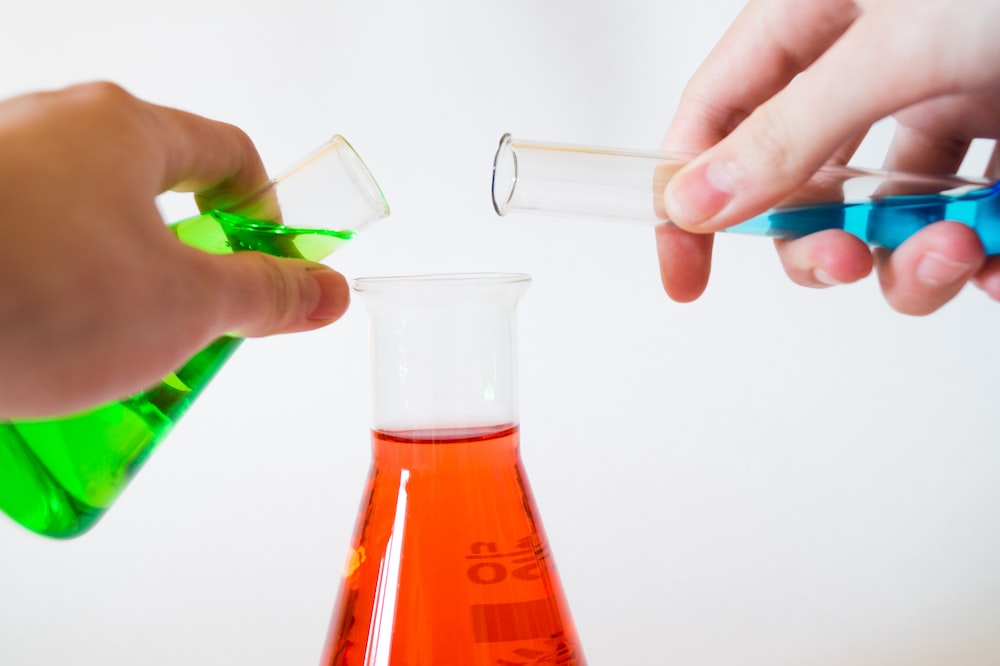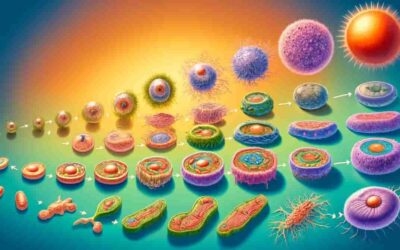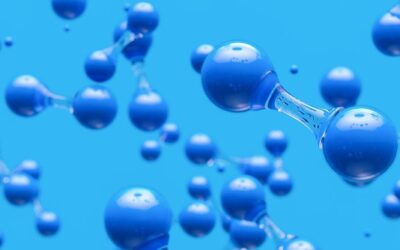Chemical reactions and equations are the fundamental building blocks of chemistry, allowing us to understand and explore the world around us on a molecular level. From the explosive reactions of fireworks to the life-sustaining processes in our bodies, chemical reactions shape our everyday experiences. In this captivating journey, we will delve into the fascinating world of chemical reactions and equations, uncovering the mysteries of how elements combine, transform, and interact with one another. We will explore the laws and principles that govern these reactions, from balancing equations to predicting products. Discover the intricacies of oxidation and reduction, the driving forces behind many chemical reactions, and learn how to decipher and write chemical equations like a seasoned chemist. Whether you’re a student seeking to ace your chemistry exams or simply a curious mind eager to understand the world at its smallest scale, this exploration of chemical reactions and equations will leave you with a newfound appreciation for the wonders of chemistry.
Types of Chemical Reactions
Chemical reactions can be classified into various types based on the changes they bring about in the reactants. One such classification is the combination reaction, where two or more substances combine to form a single product. For example, the reaction of iron and sulfur to form iron sulfide:
Fe + S → FeS
Another type of reaction is the decomposition reaction, where a compound breaks down into simpler substances. An example is the decomposition of water into hydrogen and oxygen gas through the process of electrolysis:
2H2O → 2H2 + O2
A third type is the displacement reaction, where one element replaces another in a compound. The reaction between zinc and hydrochloric acid is an example:
Zn + 2HCl → ZnCl2 + H2
These are just a few examples of the many types of chemical reactions that occur in nature and in the laboratory. Each type has its own unique characteristics and underlying principles that govern the reaction.
Balancing Chemical Equations
Balancing chemical equations is an essential skill in chemistry, as it ensures that the law of conservation of mass is upheld. According to this law, matter cannot be created or destroyed in a chemical reaction, only rearranged. Therefore, the number of atoms of each element must be the same on both sides of the equation.
To balance a chemical equation, one must adjust the coefficients in front of the reactants and products. For example, consider the combustion of methane:
CH4 + O2 → CO2 + H2O
To balance this equation, we need to ensure that there are equal numbers of carbon, hydrogen, and oxygen atoms on both sides. By adding coefficients, we can achieve the balanced equation:
CH4 + 2O2 → CO2 + 2H2O
It is important to note that balancing equations requires careful consideration of the chemical formulas and the stoichiometry of the reaction. Once the equation is balanced, it provides valuable information about the relative amounts of reactants and products involved in the reaction.
Understanding Stoichiometry in Chemical Reactions
Stoichiometry is the quantitative relationship between the amounts of reactants and products in a chemical reaction. It allows chemists to determine the amount of one substance that is needed to react completely with another, as well as the amount of product that will be formed.
The stoichiometric coefficients in a balanced chemical equation represent the relative ratios of the substances involved. For example, in the reaction:
2H2 + O2 → 2H2O
The ratio between hydrogen and oxygen is 2:1. This means that for every 2 moles of hydrogen, we need 1 mole of oxygen to completely react and form 2 moles of water.
Stoichiometry can be used to calculate various quantities, such as the amount of reactant needed, the amount of product formed, or the percentage yield of a reaction. It provides a framework for understanding and predicting the outcome of chemical reactions, allowing chemists to optimize processes and maximize efficiency.
The Role of Catalysts in Chemical Reactions
Catalysts are substances that increase the rate of a chemical reaction without being consumed in the process. They work by providing an alternative reaction pathway with lower activation energy, making it easier for the reactants to form products.
Catalysts can be classified into two types: homogeneous and heterogeneous. Homogeneous catalysts are in the same phase as the reactants, while heterogeneous catalysts are in a different phase. For example, the reaction between hydrogen peroxide and iodide ions can be catalysed by the enzyme catalase, which is a homogeneous catalyst. In contrast, the reaction between nitrogen and hydrogen to form ammonia is catalyzed by iron, which is a heterogeneous catalyst.
Catalysts play a crucial role in many industrial processes, such as the production of fertilizers, plastics, and pharmaceuticals. They enable reactions to occur at lower temperatures and pressures, reducing energy consumption and minimizing environmental impact. The study of catalysts and their mechanisms is an active area of research in the field of chemistry, with the potential to revolutionize the way we manufacture and produce chemicals.
Common Examples of Chemical Reactions in Everyday Life
Chemical reactions are not confined to the laboratory; they occur all around us, shaping our daily lives. One common example is the combustion of fuels, such as gasoline or natural gas, in our cars and homes. This reaction releases energy in the form of heat and light, allowing us to power our vehicles and heat our homes.
Another example is the process of digestion in our bodies. The enzymes in our digestive system catalyze a series of chemical reactions that break down food into smaller molecules, which can be absorbed and utilized by our cells. Without these reactions, we would not be able to extract energy or nutrients from the food we consume.
Chemical reactions also play a role in the natural world. Photosynthesis, for instance, is a complex series of reactions in plants that converts carbon dioxide and water into glucose and oxygen, using sunlight as a source of energy. This process is essential for the production of oxygen and the maintenance of life on Earth.
These examples illustrate the pervasive impact of chemical reactions in our everyday lives. By understanding the principles and mechanisms behind these reactions, we can appreciate the intricate workings of the world around us.
The Importance of Chemical Reactions in Industries
Chemical reactions are the backbone of many industries, driving processes that produce a wide range of products and materials. From the production of fertilizers and pharmaceuticals to the manufacturing of plastics and textiles, chemical reactions are instrumental in meeting our societal needs.
One example is the Haber-Bosch process, which converts nitrogen gas from the air into ammonia, a key component of fertilizers. This reaction, catalyzed by iron, revolutionized agriculture by enabling the large-scale production of nitrogen-based fertilizers, which significantly increased crop yields and food production.
Chemical reactions are also crucial in the pharmaceutical industry, where they are used to synthesize drugs and pharmaceutical intermediates. The discovery and development of new reactions and catalysts have led to the creation of life-saving medications and treatments for various diseases.
In the manufacturing sector, chemical reactions are involved in the production of plastics, textiles, and other materials. Polymerization reactions, for example, link small molecules called monomers to form long chains of polymers, giving rise to materials with a wide range of properties and applications.
The importance of chemical reactions in industries cannot be overstated. They enable the creation of new materials, the development of innovative technologies, and the improvement of our quality of life.
Chemical Equations and the Conservation of Mass
Chemical equations provide a concise representation of chemical reactions, allowing us to communicate and understand the changes that occur. They consist of reactants on the left side of the equation, separated by an arrow from the products on the right side.
One of the fundamental principles underlying chemical equations is the conservation of mass. This principle states that the total mass of the reactants must be equal to the total mass of the products. In other words, matter is neither created nor destroyed in a chemical reaction, only rearranged.
To illustrate this principle, consider the reaction between hydrogen and oxygen to form water:
2H2 + O2 → 2H2O
On the left side, we have 4 hydrogen atoms and 2 oxygen atoms, while on the right side, we have 4 hydrogen atoms and 2 oxygen atoms as well. The total mass of the reactants is equal to the total mass of the products, demonstrating the conservation of mass.
Chemical equations provide a powerful tool for understanding and predicting the outcome of reactions, allowing us to explore the intricacies of chemical transformations at a molecular level.
Factors Affecting the Rate of Chemical Reactions
The rate of a chemical reaction refers to how quickly the reactants are converted into products. Several factors can influence the rate of a reaction, including temperature, concentration, surface area, and the presence of catalysts.
Temperature plays a crucial role in determining the rate of a reaction. As temperature increases, the kinetic energy of the particles also increases, leading to more frequent and energetic collisions between the reactant molecules. This, in turn, results in a higher reaction rate. Conversely, decreasing the temperature slows down the reaction rate.
Concentration is another important factor. Increasing the concentration of reactants increases the frequency of collisions, leading to a higher reaction rate. This is because a higher concentration provides a greater number of reactant particles per unit volume, increasing the chances of successful collisions.
The surface area also affects the reaction rate. By increasing the surface area of solid reactants, we expose more particles to the surrounding reactants, leading to a higher reaction rate. This is why finely powdered substances react more quickly than large chunks.
Catalysts are substances that increase the rate of a reaction without being consumed in the process. They provide an alternative reaction pathway with lower activation energy, making it easier for the reactants to form products. Catalysts can significantly enhance reaction rates, allowing reactions to occur under milder conditions and reducing energy consumption.
By understanding and manipulating these factors, chemists can control the rate of chemical reactions, optimizing processes and improving efficiency in various applications.
Applications of Chemical Reactions in Environmental Science
Chemical reactions play a crucial role in understanding and addressing environmental issues. They are involved in processes such as air pollution, water treatment, and the degradation of pollutants.
One example is the reaction between nitrogen oxides (NOx) and volatile organic compounds (VOCs) in the atmosphere, which leads to the formation of ground-level ozone and smog. These reactions, catalyzed by sunlight, contribute to air pollution and have detrimental effects on human health and the environment.
Chemical reactions are also used in water treatment to remove pollutants and ensure the safety of drinking water. Oxidation-reduction reactions, for instance, can be employed to convert harmful substances into less toxic forms or to remove heavy metals from water sources.
In the field of environmental remediation, chemical reactions are harnessed to clean up contaminated sites and restore ecosystems. Techniques such as bioremediation and chemical oxidation utilize chemical reactions to break down or transform pollutants, mitigating their impact on the environment.
By harnessing the power of chemical reactions, environmental scientists can develop innovative solutions to address environmental challenges and promote sustainability.
Conclusion
In conclusion, chemical reactions and equations are the foundation of chemistry, allowing us to understand and explore the world at its smallest scale. They shape our everyday experiences, from the fireworks that light up the sky to the complex processes that sustain life. By classifying reactions, balancing equations, and understanding stoichiometry, we can decipher the language of chemical transformations. Catalysts enhance reaction rates, while factors such as temperature and concentration influence reaction kinetics. Chemical reactions find applications in various industries, from agriculture to pharmaceuticals, and play a crucial role in our daily lives.
As we continue to unravel the mysteries of chemical reactions, we gain a deeper appreciation for the wonders of chemistry and its profound impact on our world. Whether you’re a student seeking to ace your chemistry exams or simply a curious mind eager to understand the world on a molecular level, the exploration of chemical reactions and equations opens up a realm of knowledge and discovery. Embrace the beauty and complexity of chemistry, and let the reactions unfold before your eyes.







0 Comments